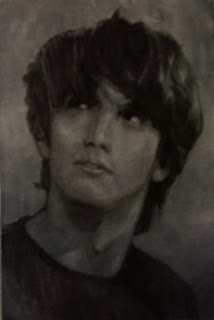I've sort of been avoiding the subject because I don't want the fact that I have fibromyalgia to control any part of my life and when I dwell on it, that gives it importance I don't want it to have. But just as it affects every aspect of my life, it also affects my art...and not always in bad ways.
In fact, when I was at my worst, painting was about the only thing I could do. It saved my sanity because it's not easy to go from perfectly healthy and active to a painful sedentary lifestyle. Don't get the wrong idea...I'm not whining...many people have worse problems than I do and over the years I've learned to live with it. And there are good periods when I feel almost normal and a lot of chronic conditions don't offer that boon.
Eventually I quit painting because the repetitive action of painting combined with standing at the easel proved too much. I can't sit and paint, it's too close to the canvas to really get a good overall feel. And when I started to dread going into the studio I knew it was over. Eventually though, I did find that I could sit and sculpt and was surprised to find that I had an even greater passion for it than painting.
I still have to pace my work habits around my condition though. The best time to work is in the morning while I still have energy. I'm much better these days than I was a few years ago and I can now get exercise mowing my lawn or doing strength exercises in the winter. I can work after the exercises, but not on a day I mowed.
Sure, sometimes it's frustrating when I have a piece I really want to work on, but in the long run I'm much more productive if I listen to my body. I take weekends off and when I work I make sure that I get up and move around every so often. I try to remember to sit correctly, though that is hard because I have a tendency to get so involved that I lose track of time and space.
I moved my work table into the living room so that even on a bad day I can get up and maybe do a few minutes work if I want to. I no longer have issues with depression since I started using Sam-e. I don't really feel any different, I just don't crash anymore. And believe me, that's a HUGE help. So it's just a matter of whether or not my body is up to it or whether I'm sleep deprived, because if a person is too tired then there's just too many mistakes made.
But most of the time I can work...not the crazy 10 hour days I used to put in, but you'd be amazed what a person can accomplish in just an average of 2-4 hours a day, even if it is split up. And my art keeps me going. I've chosen to do subjects that make me feel good and hopefully do the same for others. I constantly remind myself that I am so lucky in so many things that I can't let one stupid thing bring me down.
I'm only writing about this because I know there are other artists out there dealing with chronic pain and I know sometimes it's hard to keep going. The first thing I did to pull out of it was to do a self portrait showing myself hard hit by the fibro. I put myself inside the mouth of a t-rex dinosaur, just to show how it was eating me up. But the thing is that instead of looking defeated I looked like I knew I would win past it all. So my art taught me that instead of giving in I could fight back...until that moment I truly didn't think I could because no matter what I did, it had control.
It took time, but these days it's just something I deal with, no more importance to it than not being able to sit in the sun on a rainy day. It's just the way it is. I did another
self portrait about 5 years later...I show my age but I think I caught what is inside of me that got me through.
This might be something others want to explore, just getting a hook on something is 1/2 the value. Sometimes it seems that we have no control over things, but we do have control over ourselves. We can determine what we want to do and find ways around a problem so that we can do it.
So if you do have a chronic pain problem learn how to work with it and never let it control you, it can be done.











